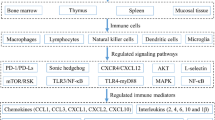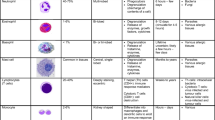Abstract
Effect of 44 colchicine derivatives on the induction of antibody response in tissue cultures was tested. Lymphatic cells from the spleen of BALB/c mice were cultivated with antigen (sheep red blood cells) and the number of antibody forming cells was determined by the plaque technique. Most compounds with the immunoinhibitory effect are derived from the colchicine formula (I). The effect was increased by introducing ethyl, formyl or methylenedioxide groups. Colchinols exerted very good immunoinhibitory effect resulting by contraction of tropolone ring C into the aromatic one. A complete loss of the effectivity was detected in the case of glucoside of colchicine, colchiceine, isocolchicine, oxycolchicine, allocolchicine and in lumiderivatives of colchicine. No correlations between the immunoinhibitory effect, toxicity and stathmokinetic effect were detected: decrease of cell viability and arrest of mitoses were not observed in cultured lymphocytes within the range of the immunoinhibitory effect. The effect of colchicine derivatives was manifested as the inhibition of lymphocyte blastogenesis, which is probably the result of membrane transport blockade.
Similar content being viewed by others
References
Allen T.D., Scarfee J.H., Crowther D.: Ultrastructural aspects of colchicine ultrasensitivity in CLL lymphocytes.Blood Cells 7, 147 (1981).
Atkinson J.P., Parker C.W.: Cytochalasin binding to macrophages.Cell. Immunol. 41, 103 (1978).
Barton N., Cook J.W., Loudon J.D.: The structure of Windaus’s deaminocolchinol methyl ether.J. Chem. Soe. (London) 176 (1945).
Berlin R.D.: Microtubules and the fluidity of the cell surface.Ann. N. Y. Acad. Sci. 253, 445 (1975).
Bernovská J., Kostka J., Sterzl J.: Haemolytic reaction in gels.Folia Microbiol. 8, 376 (1963).
Borisy G.G., Taylor E.W.: The mechanism of action of colehicine. Binding of colchicine to cellular protein.J. Cell Biol. 34, 525 (1967).
Creasey W.A.: Vinca alkaloids and colchicine.Handb.exp. Pharmacol. 38, 670 (1975).
Černoch M., Malínský J., Tělupilová O., Šantavý F.: Biologische Wirksamkeit der Colchicinderivato in Bezug auf ihre Konstitution.Arch. int. Pharmacodyn. 99, 141 (1954).
Deysson G.: Antimitotic substances.Int. Rev. Cytol. 24, 99 (1968).
Dixon F.J., McConahey P.J.: Enhancement of antibody formation by whole body X-radiation.J. Exp. Med. 117, 833 (1963).
Dustin P.: Quantitative estimation of mitotic growth in the bone marrow of the rat by the stathmokinetic (colchicine) method,;p. 50 in F. Stohlman (Ed.):The Kinetics of Cellular Proliferation. Grune & Stratton, New York 1959.
Dustin P.:Microtubules. Springer-Verlag, Berlin 1978.
Eigsti O.J.,;Dustin P.:Colchicine in Agriculture, Medicine, Biology and Chemistry. Iowa State College Press, Ames 1957.
Fagraeus A., Gormsen H.: The effect of colchicine on circulating antibodies, antibody producing tissues and blood cells in rat.Acta Pathol. Microbiol. Scand. 33, 421 (1953).
Fitzgerald T.J.: Molecular features of colchicine associated with antimitotic activity and inhibition of tubulin polymerization.Biochem. Pharmacol. 25, 1383 (1976).
Gillespie E.: Microtubules, cAMP, calcium and secretion.Ann. N. Y. Acad. Sci. 253, 771 (1975).
Hirata A.A., Redlich M.: Effect of colchicine on antibody response in hamsters.Proc. Soc. Exp. Biol. Med. 109, 628 (1962).
Jaroslow B.N., Taliaferro W.H.: The effect of colchicine on the hemolysin response in unirradiated and irradiated rabbits.J. Inf. Dis. 116, 139 (1966).
Kelleher J.K.: Tubulin binding affinities of podophyllotoxin and colchicine analogues.Mol. Pharmacol. 13, 232 (1977).
Klingenstein R.J., Dickler H.B.: The effects of pharmacologic agents on immune-complex-induced redistrivution of B-lymphocyte Fc receptors.Scand. J. Immunol. 10, 145 (1979).
Leiter J., Downing V., Hartwell J.L., Shear M.J.: Damage induced in sarcoma 37 with chemical agents. III. Colchicine derivatives related to trimethylcolchieinic acid and to colchinol.J. Nat. Cancer Inst. 13, 379 (1952).
Lettré H.: Über Mitosegifte.Ergebn. Physiol. 46, 379 (1950).
Malínsky J., Lang B.: L’effects de la colchicine, de l’isocolchicine et de l’amide de colehicine sur la mitose.Compt. rend. Soc. Biol. 145, 613 (1951).
Malínský J., Šantavý F.: Derivatives of colchicine and their biological effect (In Czech.)Lék. listy 7, 276 (1952).
Marbrook J.: Primary immune response in cultures of spleen cells.Lancet II, 1279 (1967).
Mizel S.B., Wilson L.: Nucleoside transport in mammalian cells. Inhibition by colchicine.Biochemistry 11, 2573 (1972).
Quinn F.R., Beisler J.A.: Quantitative structure-activity relationship of colchicines against P388 leukemia in mice.J. Med. Chem. 24, 251 (1981).
Quinn F.R., Neiman Z., Beisler J.A.: Toxicity quantitative structure-activity relationships of colchicines.J. Med. Chem. 24, 636 (1981).
Redman C.M., Banerjee D., Howell K., Palade G.E.: The step at which colchicine blocks the secretion of plasma protein by rat liver.Ann. N. Y. Acad. Sci. 253, 780 (1975).
Resch K., Bouillon D., Gemsa D., Averdunk R.: Drugs which disrupt microtubules do not inhibit the initiation of lymphocyte activation.Nature 265, 349 (1977).
Romppanen T., Viljanen M.K., Sorvari T.E.: Humoral immunodeficiency in chickens induced by chemical bursectomy with colchieine applied on the anal lips.Immunology 42, 391 (1981).
Schönharting M., Pfaender P., Rieker A., Siebert G.: Metabolic transformation of colchicine. I. The oxidative formation of products from colchicine in the Udenfriend system.Z. Physiol. Chem. 354, 421 (1973).
Schönharting M., Mende G., Siebert G.: Metabolic transformation of colchicine. II. The metabolism of colchicine by mammalian liver microsomes.Z. Physiol. Chem. 355, 1391 (1974).
Smith W.W.: Protective effect of a colchicine derivative in mice exposed to X-radiation.Science 127, 340 (1958)í
Stadler J., Franke W.W.: Characterization of the colchicine binding of membrane fractions from rat and mouse liver.J. Cell Biol. 60, 297 (1974).
Steen H.B., Lindmo T.: The effect of colchicine and colcemid on the mitogen-induced blastogenesis of lymphocytes.Eur. J. Immunol. 8, 667 (1978).
Stenzel K.H., Schwartz R., Rubin A.L., Novogrodsky A.: Potentiation of lymphocyte activation by colchicine.J. Immunol. 121, 863 (1978).
Santavy F., Lang B., Malínský J.: L’action mitotique et la taxicité des nouvelles substances isolées du colchique (Colchicum autumnale L.).Arch. int. Pharmacodyn. 84, 257 (1950).
Šantavý F., Hoščálková Z., Podivínský R., Potěšilová H.: Isolierung weiterer Substanzen aus den Knollen der Hebstzeitlose (Colchicum autumnale L.);Coll. Czech. Chem. Comm. 19, 1289 (1954).
Šantavý F.: Alkaloides of meadow-saffron and their derivatives. (In Czech).Avicenum, Praha 1958.
Šantavý F.: Colchicum alkaloidsand related substances their chemistry and biology.Acta Univ. Olomuc., Fac. Med. 90, 15 (1979).
Šantavý F.: Alkaloids from the plants of the subfamilyWurmbaeoideae.Heterocycles 15, 1505 (1981).
Šterzl J.: Effect of some metabolic inhibitors on antibody formation.Nature 189, 1022 (1961).
Šterzl J., Mandel L.: Estimation of the inductive phase of antibody formation by plaque technique.Folia Microbiol. 9, 173 (1964).
Šterzl J.: Regulatory intervention during differentiation and proliferation of activated B cells.Allergol. Immunopathol. Suppl. IV, 7 (1977).
Šterzl J.: Immunopharmacology and its toxicological problems.Arch.Toxicol.Suppl. 4, 109 (1980).
Šterzl J., Cudlín J., Steinerová N., Johanovská D., Milerová J.: The immunoinhibitory and immunostimulatory effects of hydroxyanthra- and hydroxynaphthoquinone derivatives.Folia Microbiol. 26, 169 (1981).
Tanaka N., Coons A.H.: The effect of colchicine on antibody production.Butt. N. Y. Acad. Med. 32, 171 (1956).
Thomson A.E.R., Robinson M.A.: Cytological action of colchicinein vitro on lymphocytes in chronic lymphocytic leukaemia.Lancet-II, 868 (1967).
Ukena T.E., Berlin R.D.: Effect of colchicine and vinblastine on the topographical separation of membrane functions.J. Exp. Med. 136, 1 (1972).
Weissmann G., Goldstein I., Hoffstein S., Tsung P.-K.: Reciprocal effects of cAMP and cGMP on microtubule-dependent release of lysozomal enzyme.Ann. N. Y. Acad. Sci. 253, 750 (1975).
Wilson L.: Microtubules as a good receptor: pharmacological properties of microtubule protein.Ann. N. Y. Acad. Sci. 253, 213 (1975).
Yahara I., Edelman G.M.: Modulation of lymphocyte receptor mobility by concanavalin A and colchicine.Ann. N. Y. Acad. Sci. 253, 455 (1975).
Zweig M.H., Chignell C.F.: Interaction of come colchicine analogs, vinblastine and podophyllotoxin with rat brain microtubule protein.Biochem. Pharmacol. 22, 2141 (1973).
Author information
Authors and Affiliations
Rights and permissions
About this article
Cite this article
Šterzl, J., Šantavý, F., Sedmera, P. et al. Effect of colchicine derivatives on the antibody response inducedin vitro . Folia Microbiol 27, 256–266 (1982). https://doi.org/10.1007/BF02877126
Received:
Issue Date:
DOI: https://doi.org/10.1007/BF02877126




